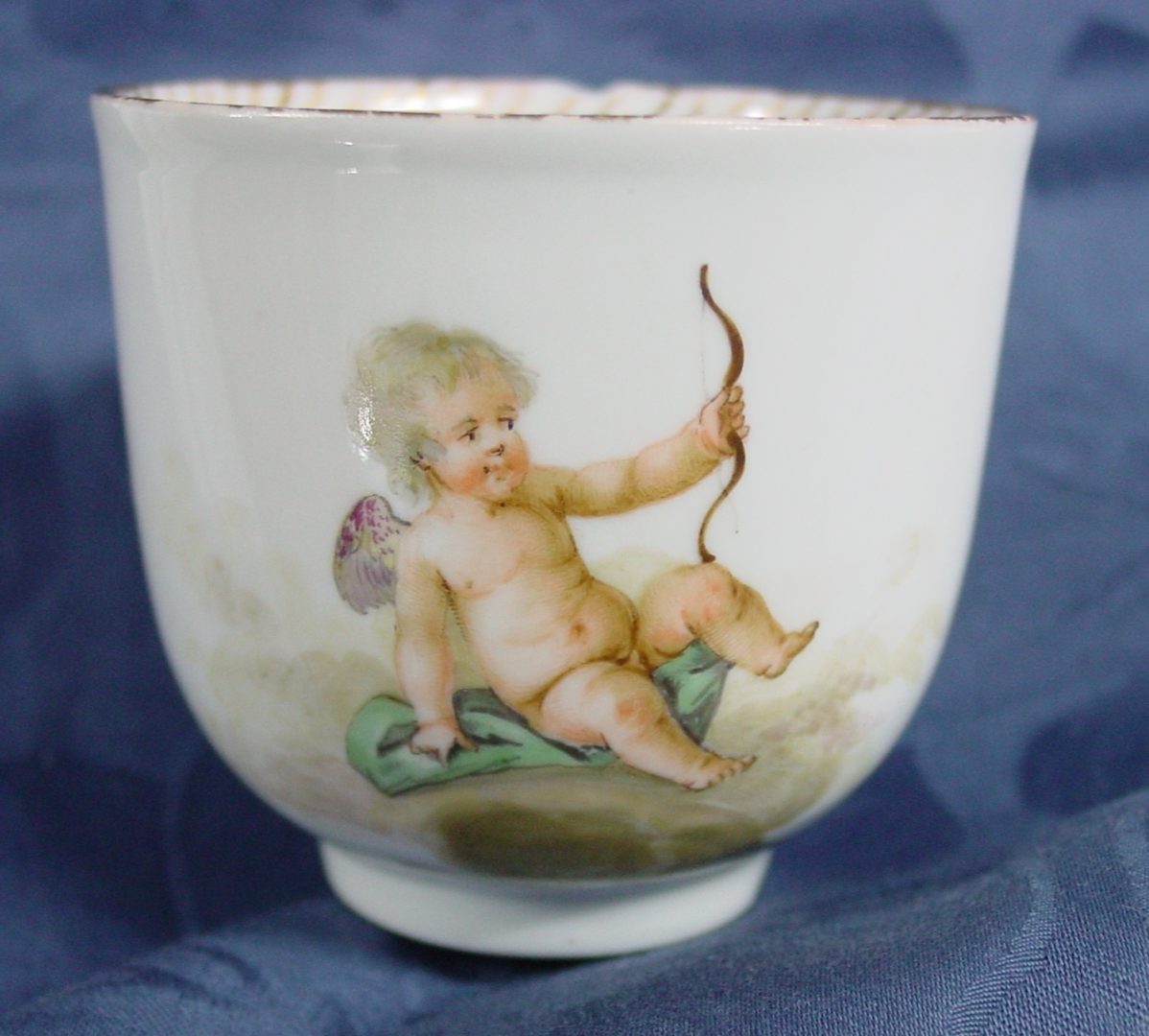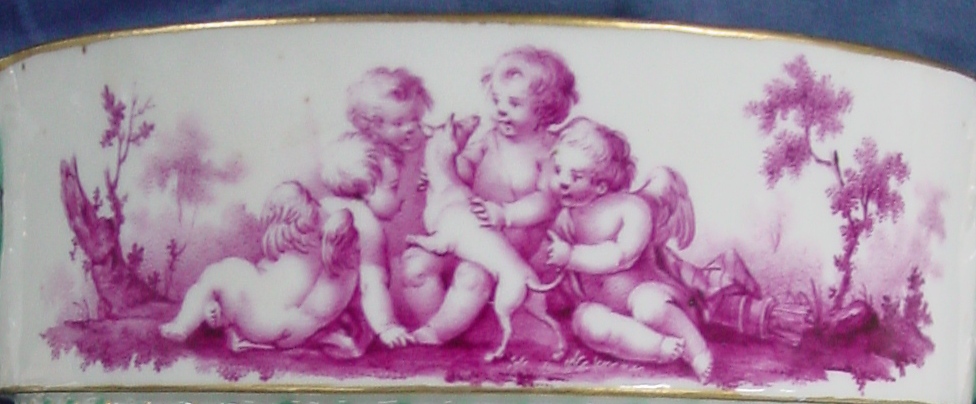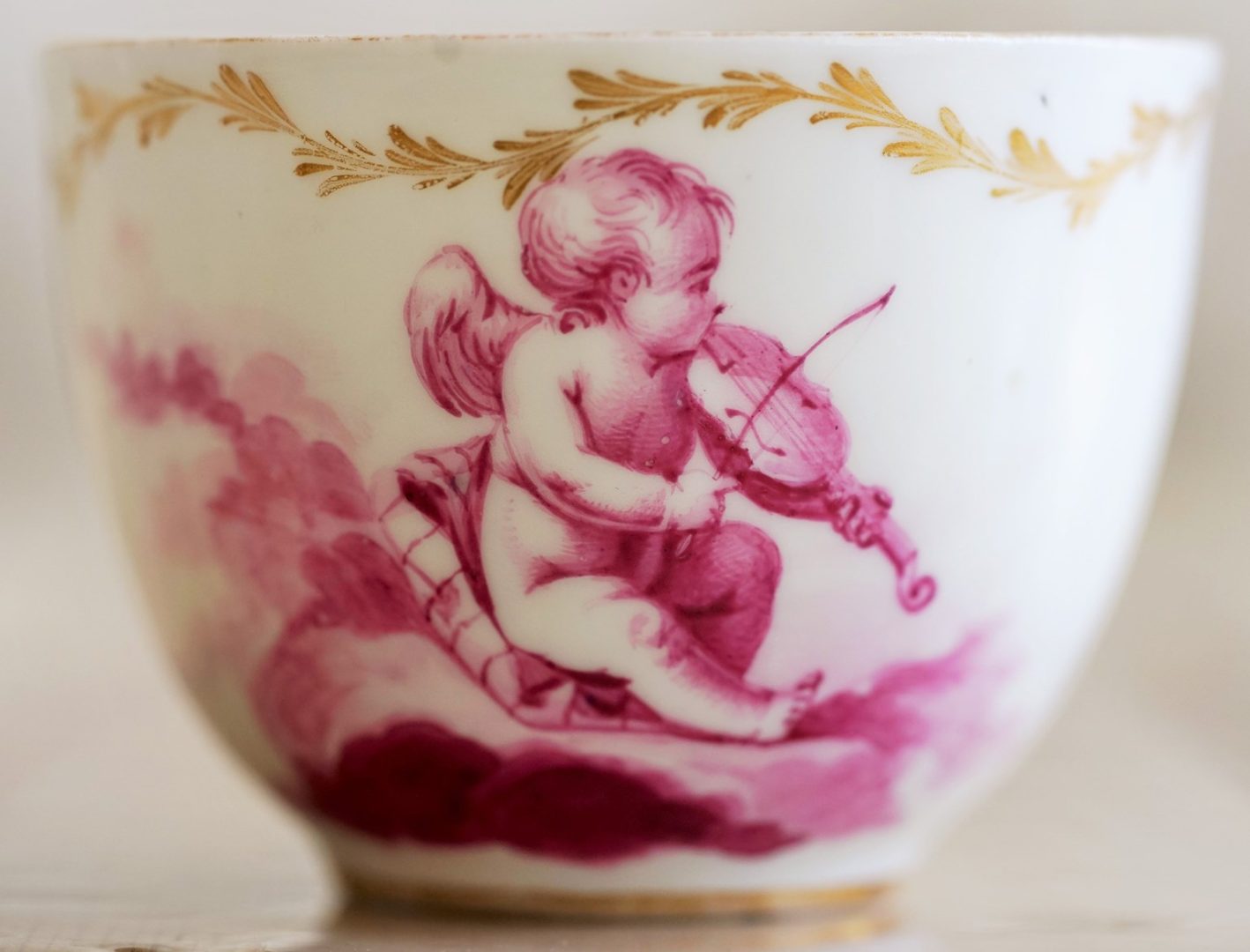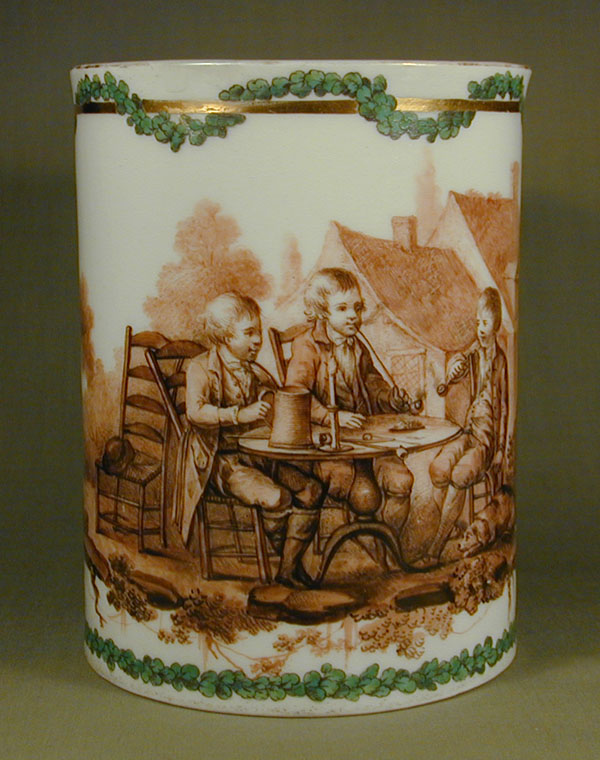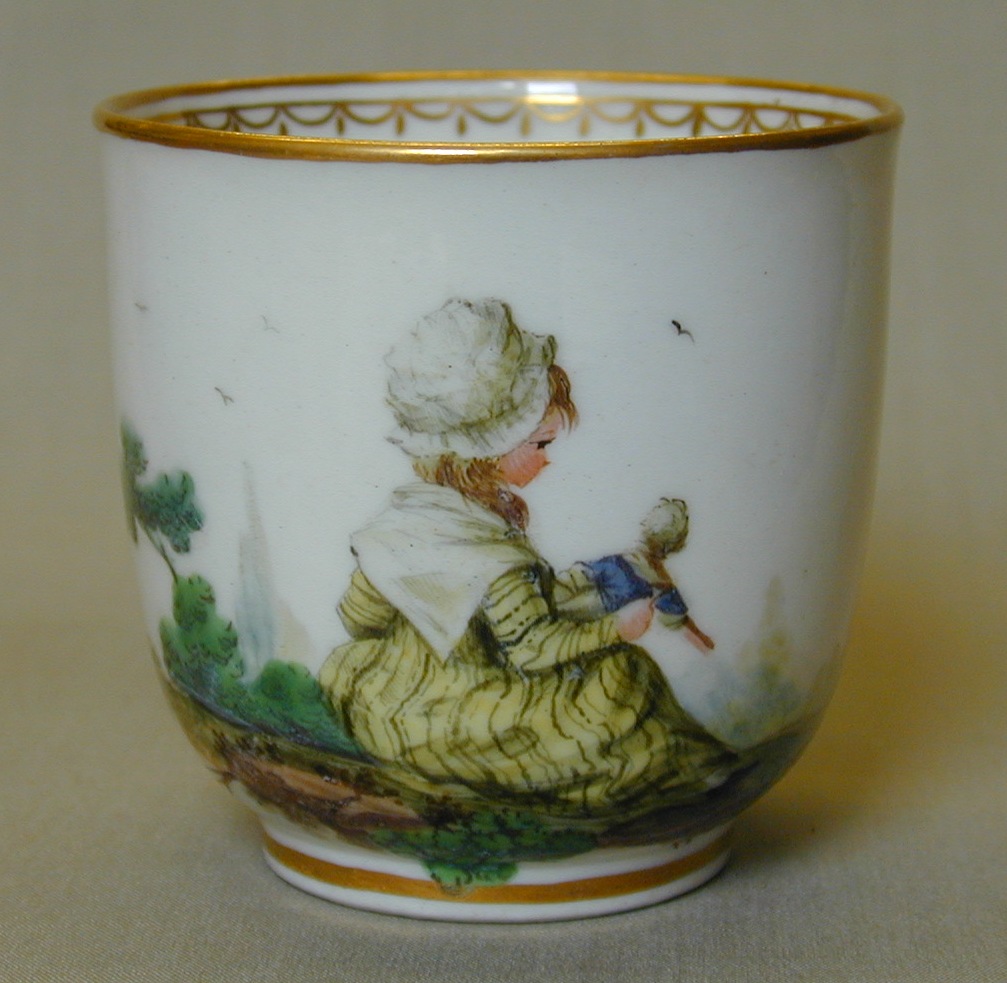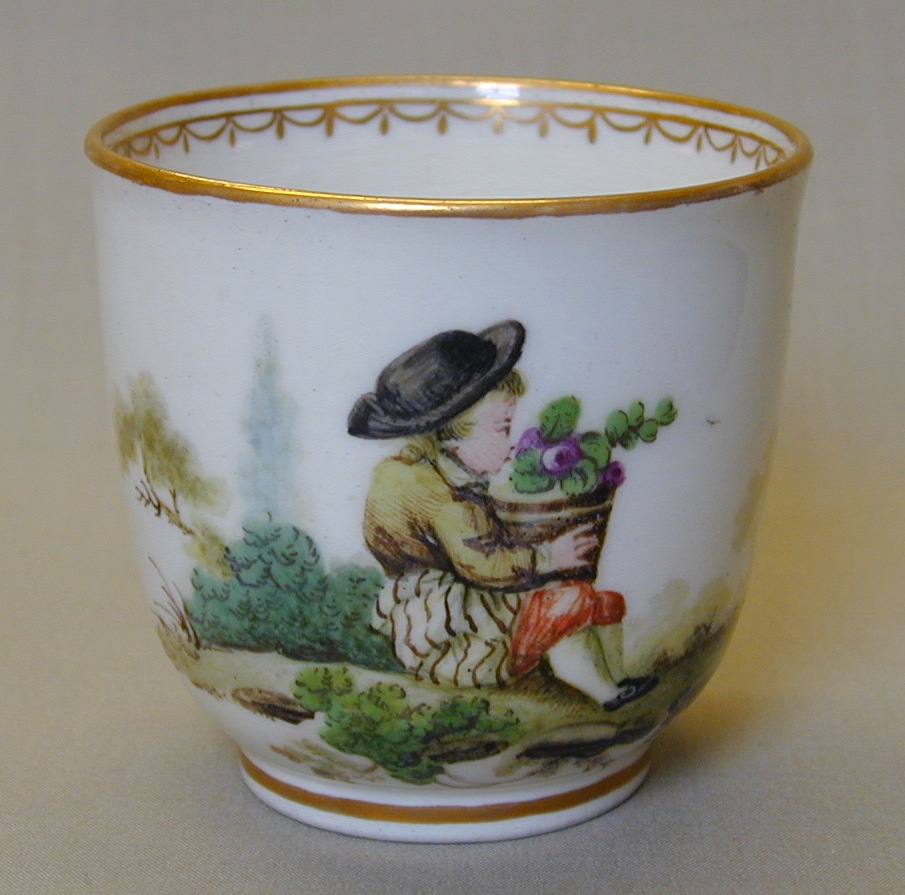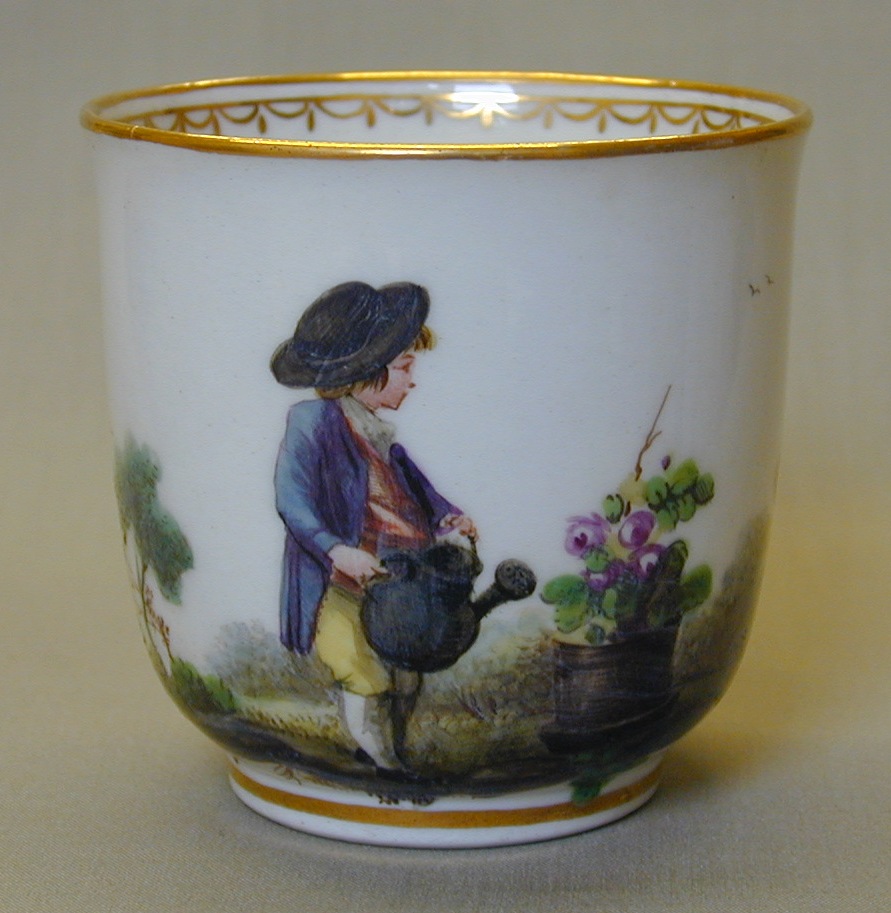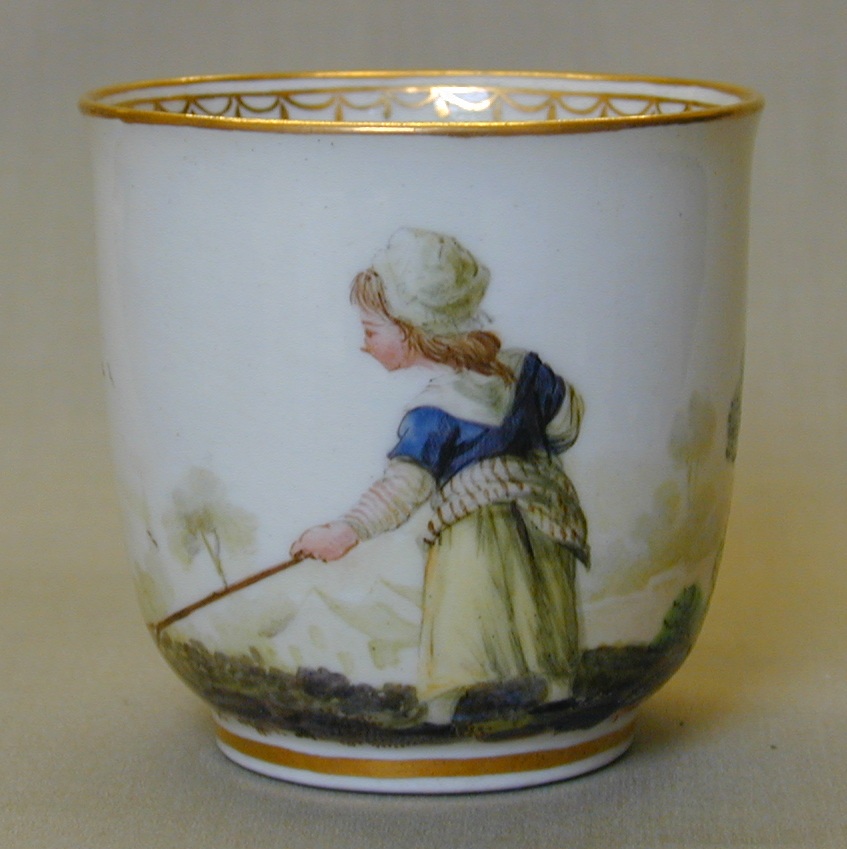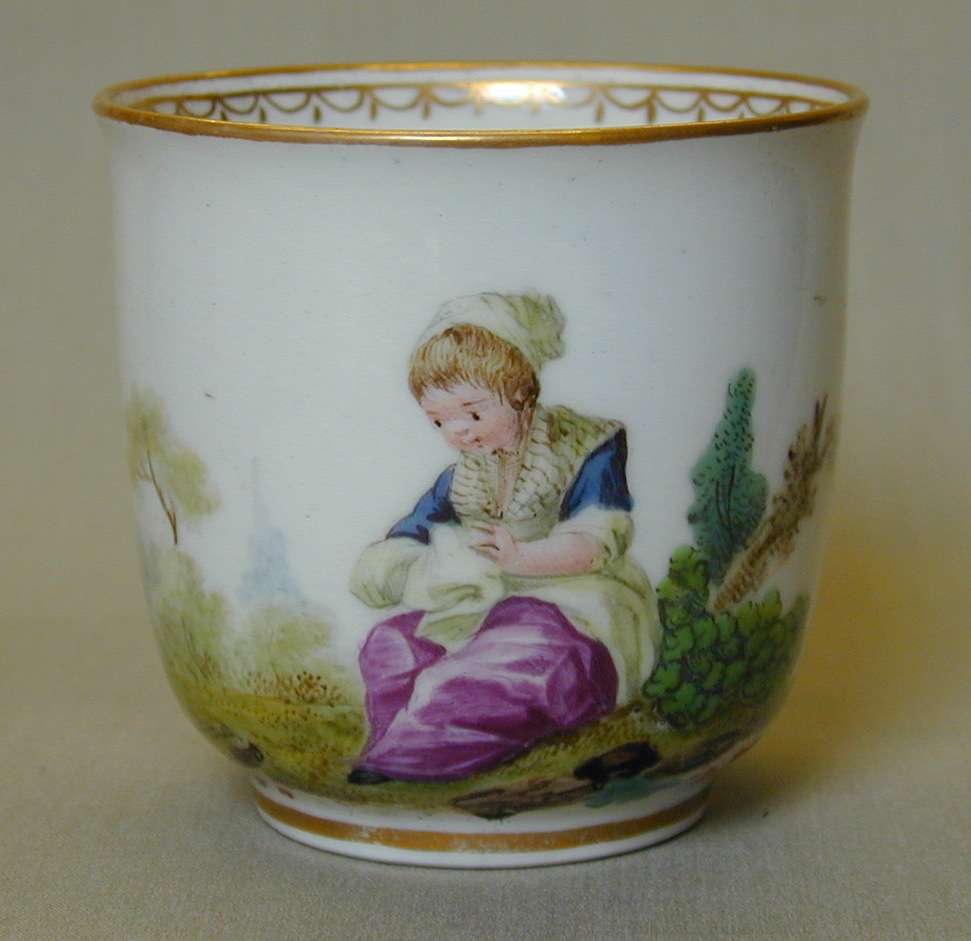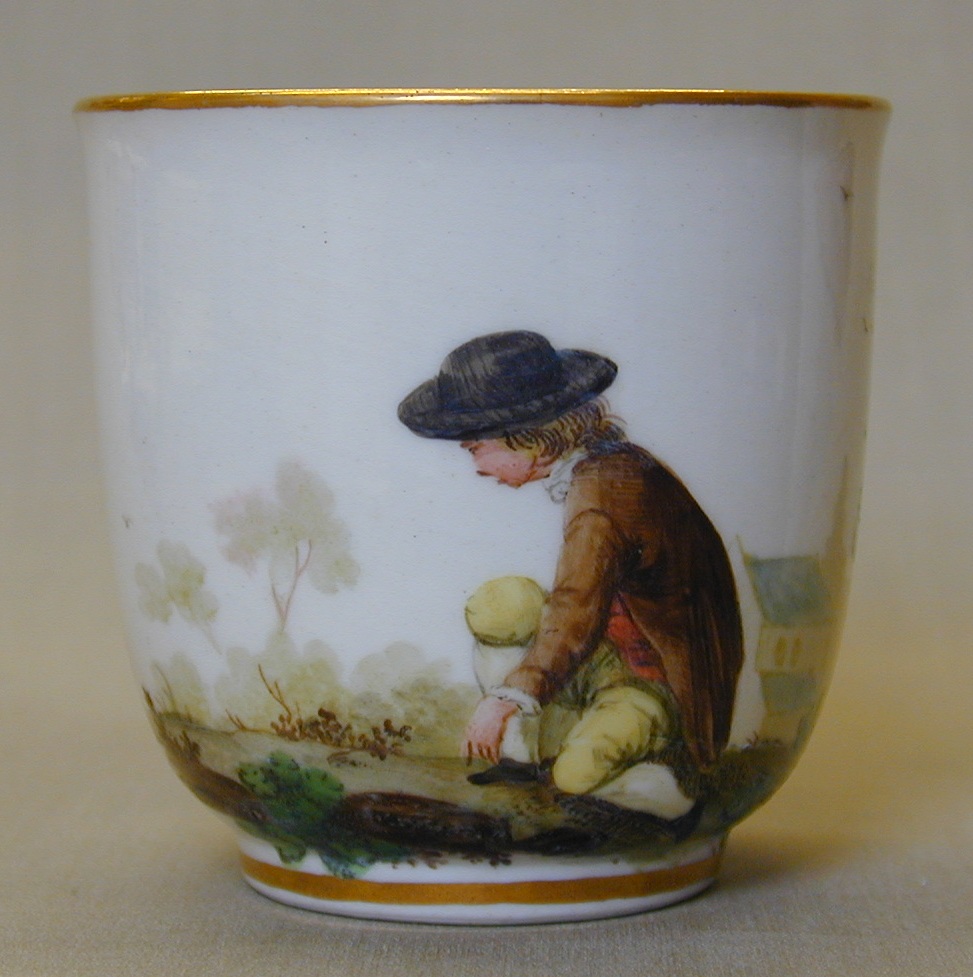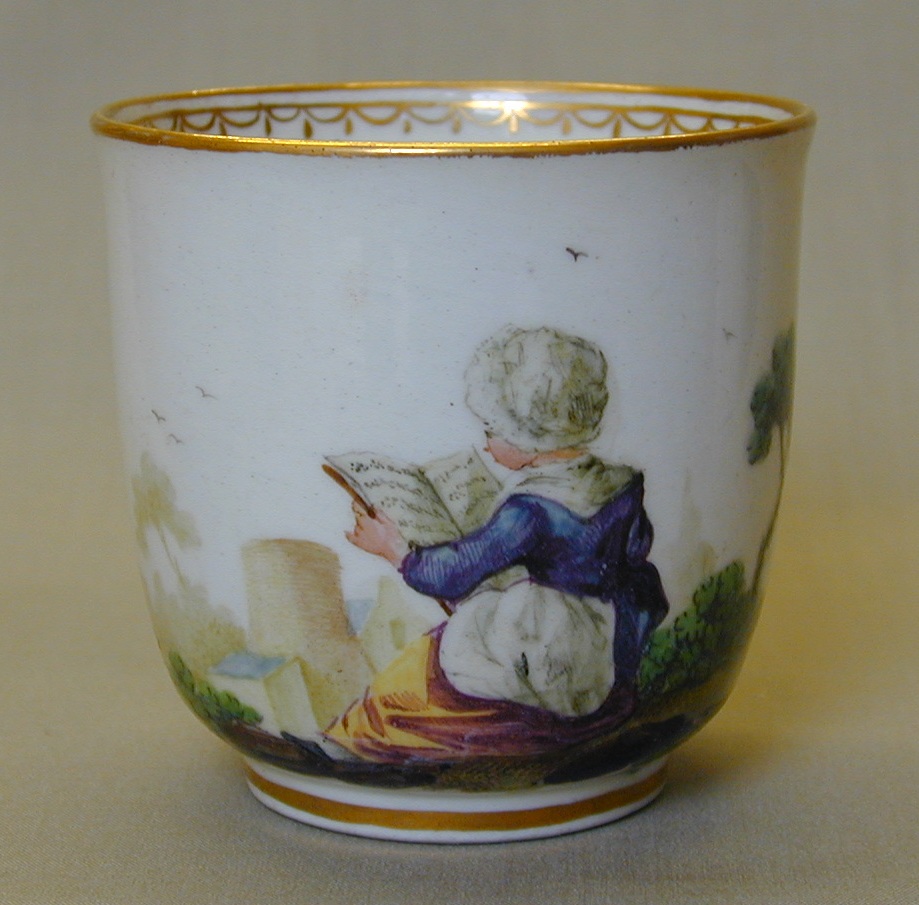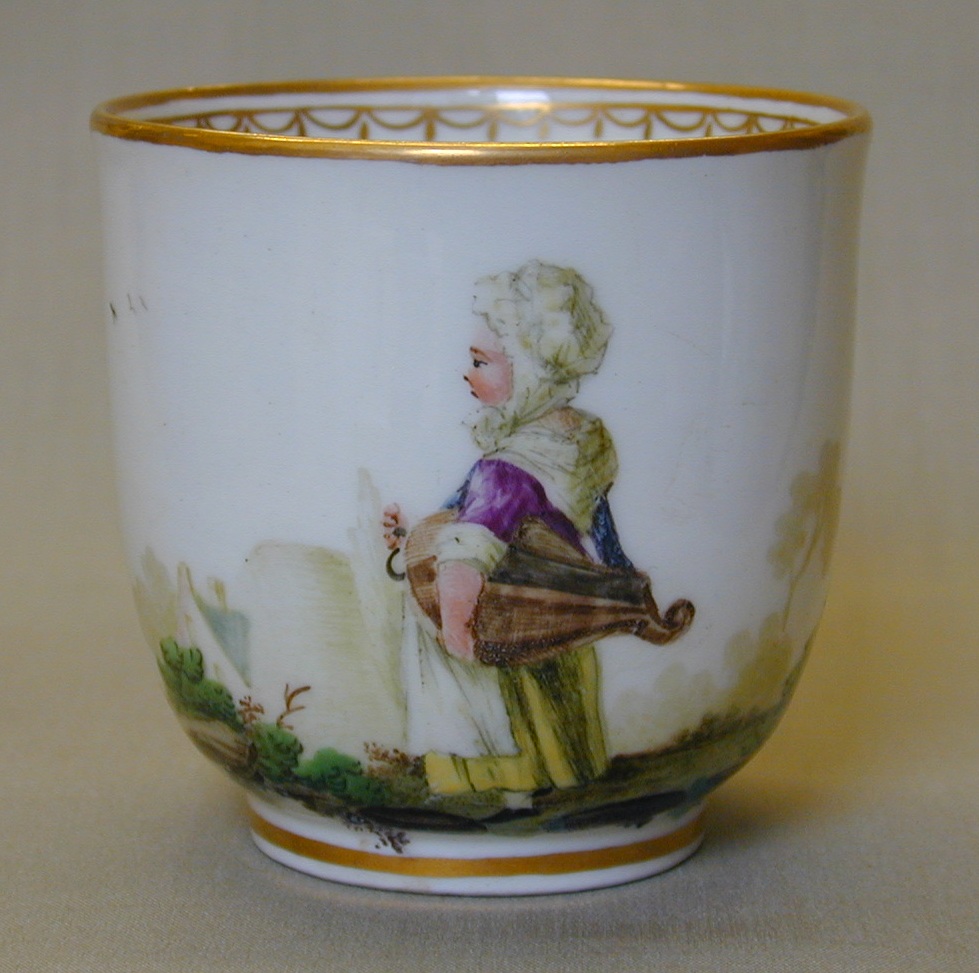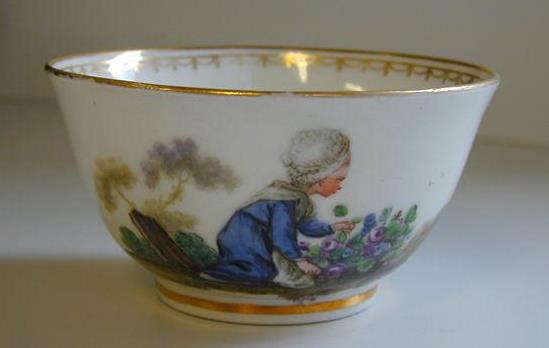1 A putto holding a bow with a broken string, painted on an Ansbach/Hague porcelain coffee cup, c. 1783, by Duvivier. Height 6.3 cm. Collection Rijksmuseum, Amsterdam (RBK 14563-F.I). Photo by the author.
Fidelle Duvivier demonstrated his exceptional gifts for painting cherubs or putti on porcelain throughout his career – both in England and on the Continent (as mentioned in blogpost #13: ‘More Cherubs on Clouds, painted in The Hague’ – Feb. 27, 2018). Examples have been identified at every manufactory where he was employed – at Derby, Sceaux (i), Loosdrecht, on Ansbach porcelain decorated at The Hague (1), with one late example (5) known from the period of his second stay in England, when he worked for the New Hall manufactory, c. 1785-90. Most were painted in puce camaïeu, and some of his finest examples are found on Loosdrecht porcelain, with a new example shown below (3).(ii)
4 A detail of a Loosdrecht hard-paste porcelain cup, c. 1783, showing a putto by Duvivier playing a violin. Height 5 cm. Photo: Collection Elvera Siemons, the Netherlands. ©Elvera Siemons
But by the time Duvivier left the Netherlands around 1785 for Staffordshire, and began working for the New Hall factory, decoration with Boucher-inspired putti was evidently no longer fashionable or much in demand. However, we see from the surviving New Hall covered sugar bowl (5) that he must have created at least one such service, perhaps to demonstrate to his new employers his mastery in this category of decoration. (This rare piece certainly helped me to identify similar Duvivier decoration at many of his former places of employment).
Judging from both his earlier Dutch work and that done in Staffordshire, we get the clear impression that he was fond of children and enjoyed portraying their many activities, games and pastimes. Duvivier developed these themes extensively in the decoration of one notable dinner service kept at Kasteel Duivenvoorde, in Voorschoten near The Hague.(iii)
The next two examples here were decorated for the New Hall factory. In (6) we see a mug with a scene painted in sepia brown showing three young boys sitting at a round table outdoors, smoking pipes or drinking ale.(iv) It is striking how angelic these youthful faces still appear – as if they had once been cherubs that had abandoned their wings and outgrown their diminutive pudginess, slipping into clothing that would make them look like little gentlemen, or at least old enough to be able to drink and smoke without drawing attention to themselves! Could that also be the case with the young lad on the New Hall cup in (2), who might just be refreshing his former marksmanship skills?
Height of teapot c. 14 cm. Unmarked. (Whereabouts unknown). This photo first appeared in a 1925 Sotheby’s advertisement in The Connoisseur magazine.
Photo reproduction by the author.
In any event, we next see more young folk on a documented New Hall teapot (7), one that was last seen at a Sotheby’s auction in London in 1925 and in a magazine advertisement of that year.(v) No one knows its present owner or whereabouts, but there may still be hope: the mug in (6) hadn’t been seen for 60 years when it suddenly materialized at an English country auction house in 2003.(vi)
The teapot shows children playing Blind Man’s Buff, a subject Fidelle had also depicted on a Loosdrecht plate a few years earlier.(vii) The gold loop and pendant chain pattern visible above the children is also present inside the New Hall cups illustrated here (2, 8-15), indicating that they all likely once belonged to the service that included this documented New Hall teapot.(viii)
These nine groove-handled cups (with no saucers) have been in the Wardown House Museum & Gallery in Luton, Bedfordshire since 1928 and some have been featured in New Hall porcelain literature as well as Major Tapp’s writings on Fidelle Duvivier.(ix) On these cups we see Duvivier’s children engaged in gardening activities, handling watering cans, garden rakes and potted plants. Or, they’re making music, practicing archery, or just pursuing other quiet children’s pastimes, like the charming girl in (8), playing with her doll. A few years ago two associated tea cups (16, 17) were discovered in the collections of the National Museum of Scotland in Edinburgh.
All photographs are reproduced with the kind permission of Pat Preller, New Hall expert. The coffee cups measure approximately 6.3 cm high.
NOTES
(i) The earliest known examples appear on Mennecy porcelain, as Duvivier was painting undecorated Mennecy blanks while employed at Sceaux, c. 1766-68. See In the Footsteps of Fidelle Duvivier, p. 30 (no. 43), for a Mennecy soft-paste porcelain jug with his putti.
(ii) This decoration appears on the reverse side of the covered vase shown on pages 67-68 in Footsteps (no. 84 a,b).
(iii) Mentioned in Charlotte Jacob-Hanson, “Fidelle Duvivier: The Painter and his World – Collected Memories,” Northern Ceramic Society Newsletter, December 2016, pp. 45-53 (posted at www.academia.edu); the Duivenvoorde service is also discussed in Footsteps, pp. 62-63, 70, 73.
(iv) At the rim of this piece is a green foliate garland entwining a gilt band, just as Fidelle used on another signed New Hall mug of the same approximate size, illustrated in Footsteps, p. 6 (no. 5). On it appears a finely painted scene in polychrome with adults, some on horseback, in front of a tavern. The Victoria and Albert Museum, London, has two more slightly smaller New Hall mugs by Duvivier, one signed twice, which also feature scenes with young people eating at what appear to be outdoor tavern tables (see C.128.1977 and C.151-1977 online). Tavern games and scenes also appear in Duvivier’s Loosdrecht decoration. See the Kasteel Duivenvoorde website, www.kasteelduivenvoorde.nl – click on Kasteel (Castle), Museum, Collectie; in the Filter click on Keramiek, Europees porselein, Manufactuur Oud Loosdrecht – see DV3142.P88 (a brawl behind a tavern); P29, P33, showing two tavern games.
(v) Geoffrey Godden also illustrates this teapot as a wood-cut engraving that was first published in the Art Journal of 1864 and later in Llewellynn Jewitt’s work, The Ceramic Art of Great Britain (1878). Jewitt once owned the piece and wrote he had traced its ownership from Charles Bagnall, a former partner in the New Hall concern. G. Godden, New Hall Porcelains (Woodbridge, Suffolk: Antique Collectors’ Club, 2004), p. 166.
(vi) This mug was auctioned by Trembath Welch, Great Dunmow, Essex on 14 July 2003 (realized £9500). It had once belonged to Major William H. Tapp and was pictured in his first article on Fidelle Duvivier published in Apollo magazine, December 1940, p. 163 (Fig. VII). Tapp recognized it as Duvivier’s work but erroneously thought the mug was made by Caughley.
(vii) See Charlotte Jacob-Hanson, op. cit. (2016), Figure 7, and Footsteps, p. 70 (no. 87).
(viii) The Boston Museum of Fine Arts also has a New Hall soft-paste porcelain tea canister belonging to this service. Pictured in blogpost #5, February 20, 2017, (no. 4).
(ix) Major Tapp showed two of these cups in his 1941 article on F. Duvivier, Apollo magazine, March 1941, p. 59, but erroneously attributed them to Worcester. David Holgate also features two of them in “Fidelle Duvivier Paints New Hall,” ECC Transactions, Vol. 11, pt. 1, (1981), p. 22 (PL 8).The Wardown House Museum & Gallery is also home to the signed New Hall cup with an animal fable theme featured in blogpost #8, July 15, 2017.

